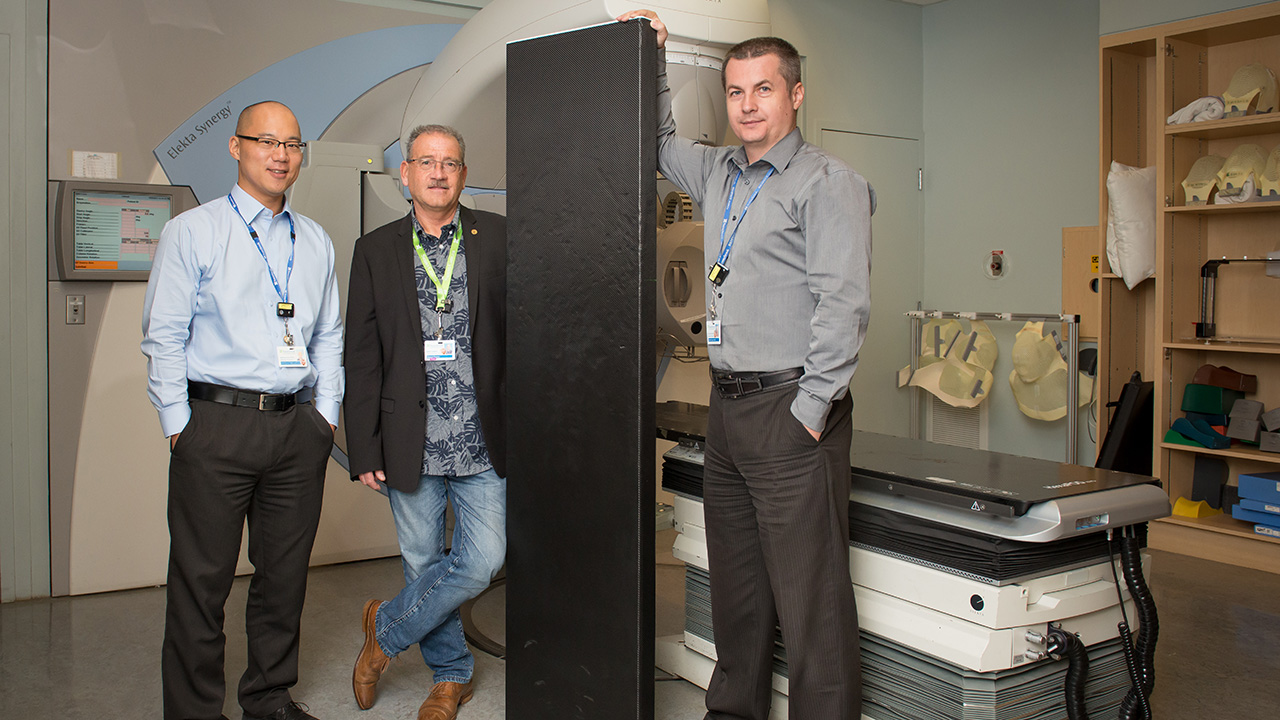Answering the call
If necessity is the mother of invention, then there’s no shortage of progenitors in health care. In oncology, for example, opportunities for innovation abound—from finding ways to detect cancer earlier, to customizing treatment and reducing adverse effects.
Researchers at Sunnybrook’s Odette Cancer Centre (OCC) who were alerted to a complication of radiation therapy have come up with a simple, elegant solution. Drs. Anthony Kim and Alex Karotki, medical physicists, and Harry Easton, who leads the centre’s mechanical division, were informed by oncologists at OCC that some patients receiving therapy for rectal cancer were developing skin peeling and redness on the buttocks and back during radiation treatment. Dr. William Chu, a clinician-investigator at Sunnybrook Research Institute, was one of the doctors who raised the issue. He recalls one case in particular: “It was definitely noticeable. [Her skin] was developing more redness than usual as the weeks went by,” he says, noting that patients who have radiotherapy are treated for 10 minutes every day for nearly six weeks.
The need for the apparatus arose about two years ago when the centre switched to a new treatment delivery technique called volumetric arc therapy, or VMAT, which allows radiation beams to be shaped precisely around a tumour. The technique enables patients to be treated lying on their backs; elsewhere, it is standard practice for patients to lie on their stomachs during radiotherapy. “With the VMAT technique we can ‘scallop’ the dose around the target, so we can treat patients supine, which is more stable and comfortable,” says Karotki.
Lying face down during treatment is especially difficult for patients who are elderly and frail, and thus, more likely to fall off the equipment, notes Kim. He and his team did research comparing the positions. Their data, which Kim says will be published soon, show that the supine position is safer and more comfortable. Moreover, lying on one’s back enhances the ability of clinicians to reproduce the treatment setup, owing to the stability of the position. The only wrinkle, however, is that lying on the table supine puts patients at greater risk of skin side effects. Kim explains: “This is how the radiation beam enters into tissue: it builds up from a very low dose, spikes and then falls off. The problem is, when you have these beams going through the treatment table that the patient lies down on, it ‘eats up’ some of that build-up area, so that the dose spikes close to the skin, as opposed to deeper into the tissue, and skin is radiation-sensitive. So we built this,” he says, pointing to the device.
Their workaround has patients lying on the skin-sparing board during treatment. Measuring about six feet tall and 20 inches wide, and made of Styrofoam, the board sits on top of the radiation equipment and acts as a buffer between the table and the patient’s backside, thus minimizing build-up of radiation at the skin’s surface. Wrapped around the board is a textured, black adhesive covering made by 3M. The team tested several materials before Easton found the wrap—used mainly to decorate cars—online. The protective layer needed to be durable, thin, cost-effective and, importantly, easy-to-clean and nonporous to prevent infection. The 3M wrap, which adheres to the board in a single piece, fit the bill.
Applying what is essentially a giant piece of tape to the foam board was “tricky,” says Easton, who notes it is a two-person job. He and a colleague have made 10 of them so far. “We got better and better at it as we went on,” says Easton, smiling.
The simple design of the device belies the research behind it. Before it could be used clinically, the researchers had to run tests to determine the effect it would have. They did experiments to measure how much radiation a patient would receive at the skin’s surface with and without the board. They found the board had a skin-sparing effect of about 10%. “When translated to a standard rectal cancer patient, that’s equivalent to about four to five Gray [units of radiation], which is enough to reduce skin toxicity,” says Kim.
The device has been used clinically for about a month, with no reports of radiation burns. There are eight of them in service at the OCC, which is one of the busiest cancer centres in Canada. Chu estimates more than 100 people are treated for rectal cancer at Sunnybrook each year.
Kim and his colleagues seek to commercialize the device via a licensing agreement to improve treatment of rectal cancer patients everywhere. The skin-sparing board would be a fraction of the cost of the “belly boards” used in other cancer centres, which runs a few thousand dollars. “It would be great to have this out there because I think every radiation therapy clinic would benefit from this,” says Kim. “Nothing like this exists on the market. If we could have bought this, we wouldn’t have done this.”
In a nutshell
- Sunnybrook researchers developed a skin-sparing board to prevent burns from radiation treatment for rectal cancer.
- Patients lie on the board during treatment to minimize build-up of radiation at the skin’s surface.
- It has been used clinically for about a month, with no reports of radiation burns.







